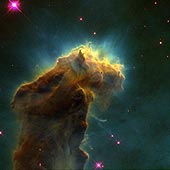|
COMETS EARTH JUPITER KUIPER BELT MARS MERCURY METEORITES NEPTUNE OORT CLOUD PLUTO SATURN SOLAR SYSTEM SPACE SUN URANUS VENUS ORDER PRINTS
PHOTO CATEGORIES SCIENCEVIEWS AMERICAN INDIAN AMPHIBIANS BIRDS BUGS FINE ART FOSSILS THE ISLANDS HISTORICAL PHOTOS MAMMALS OTHER PARKS PLANTS RELIGIOUS REPTILES SCIENCEVIEWS PRINTS
|
Related Documents
Download Options
This eerie, dark structure, resembling an imaginary sea serpent's head, is a column of cool molecular hydrogen gas (two atoms of hydrogen in each molecule) and dust that is an incubator for new stars. The stars are embedded inside finger-like protrusions extending from the top of the nebula. Each "fingertip" is somewhat larger than our own solar system. The pillar is slowly eroding away by the ultraviolet light from nearby hot stars, a process called "photoevaporation". As it does, small globules of especially dense gas buried within the cloud is uncovered. These globules have been dubbed "EGGs" -- an acronym for "Evaporating Gaseous Globules". The shadows of the EGGs protect gas behind them, resulting in the finger-like structures at the top of the cloud. Forming inside at least some of the EGGs are embryonic stars -- stars that abruptly stop growing when the EGGs are uncovered and they are separated from the larger reservoir of gas from which they were drawing mass. Eventually the stars emerge, as the EGGs themselves succumb to photoevaporation. The stellar EGGS are found, appropriately enough, in the "Eagle Nebula" (also called M16 -- the 16th object in Charles Messier's 18th century catalog of "fuzzy" permanent objects in the sky), a nearby star-forming region 6,500 light-years away in the constellation Serpens. The picture was taken on April 1, 1995 with the Hubble Space Telescope Wide Field and Planetary Camera 2. The color image is constructed from three separate images taken in the light of emission from different types of atoms. Red shows emission from singly-ionized sulfur atoms. Green shows emission from hydrogen. Blue shows light emitted by doubly- ionized oxygen atoms. Credit: Jeff Hester and Paul Scowen (Arizona State University), and NASA |
